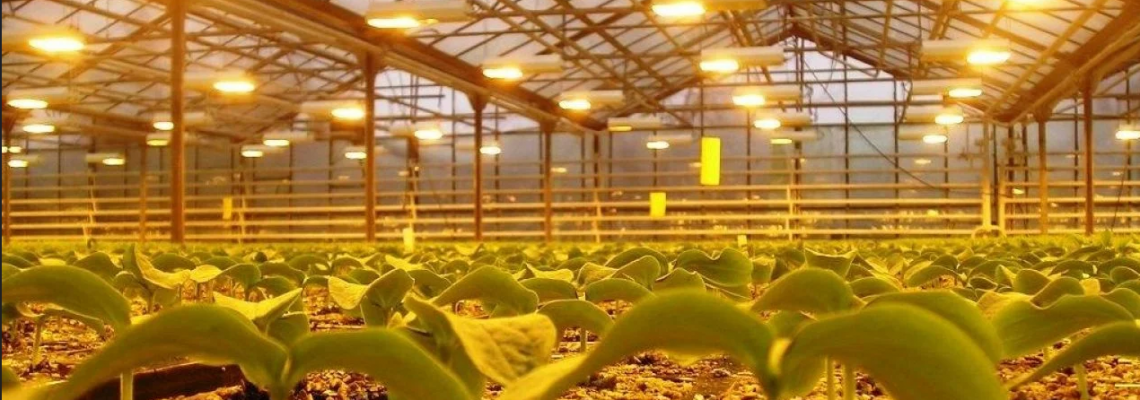
Greenhouse agriculture is undergoing a rapid transformation, driven by increasing global food demands, environmental concerns, and advancements in agricultural technology. One of the most critical areas of innovation is lighting. Traditionally, High-Pressure Sodium (HPS) and fluorescent lights have been used to support plant development in greenhouses. These lighting systems, while effective in their time, come with limitations such as high energy consumption, excess heat output, and limited spectral control.
Enter modern LED lighting systems highly efficient, cooler-running, and fully customizable. LEDs offer growers the ability to fine-tune light spectrums to match specific crop needs across all growth stages. With energy savings of up to 70% over traditional systems and lifespans that exceed 50,000 hours, LEDs are not just a technological improvement they're a sustainable solution for the future of farming.
As more growers shift to indoor and greenhouse farming to combat challenges like limited arable land, unpredictable weather, and urban food demand, choosing the right grow light system has never been more important. In this blog, we break down the advantages and disadvantages of traditional and modern lighting systems to help growers make informed decisions aligned with their goals, budget, and long-term success.
Traditional Lighting Systems: HPS and Fluorescents
High-pressure sodium (HPS) lights have long been the go-to choice for greenhouse growers, especially during the flowering stage. Their powerful output and deep canopy penetration encourage strong growth and bud development. Similarly, fluorescent lights such as T5 and compact fluorescent lamps (CFLs) have been widely used for seedling propagation and vegetative stages due to their low cost and gentle light output.
However, both systems have notable drawbacks. HPS lights generate a significant amount of heat, requiring costly cooling systems and posing a risk of heat stress to plants. They also consume large amounts of electricity, contributing to high operational costs and carbon emissions. Fluorescent lights, while energy-friendlier than HPS, are less effective for full-cycle growing and contain mercury, which raises environmental disposal concerns.
Modern Lighting Systems: LED Technology
LED grow lights represent the next generation of agricultural lighting. They offer a host of benefits that address the limitations of traditional systems. LEDs are highly energy-efficient, consuming up to 70% less power than HPS while providing equivalent or superior light intensity. This results in lower energy bills and reduced environmental impact.
One of the most significant advantages of LEDs is spectrum control. Modern LED systems can be tuned to emit specific wavelengths tailored to different stages of plant growth. For instance, blue light promotes vegetative development, while red and far-red wavelengths enhance flowering and fruiting. Full-spectrum LEDs mimic natural sunlight, supporting robust growth throughout the plant lifecycle.
LEDs also produce minimal radiant heat, reducing the need for additional cooling and allowing for closer placement to plants. This is particularly valuable in vertical farming setups, where space optimization is crucial.
Performance and Crop Yield
When comparing performance, LED grow lights generally outperform traditional lighting in terms of crop yield and quality. With precise spectrum delivery and better environmental control, plants grow faster, healthier, and more uniformly. HPS systems may still excel in certain flowering applications, but their one-size-fits-all spectrum and heat output make them less adaptable than LEDs.
Fluorescents are best suited for small-scale or hobbyist growers due to their lower intensity and limited effectiveness beyond early-stage growth. In contrast, LEDs support high-density planting and full-cycle production, making them ideal for commercial operations.
Energy Efficiency and Cost Savings
Energy efficiency is where LED systems shine. Though the initial investment is higher, the long-term savings are substantial. Lower energy consumption, reduced HVAC requirements, and fewer bulb replacements all contribute to a strong return on investment. Quality LED fixtures can last over 50,000 hours, compared to 10,000-24,000 hours for HPS and even less for fluorescents.
Additionally, many governments and utilities offer rebates and incentives for adopting energy-efficient technologies, further offsetting the upfront cost of LEDs.
Environmental Impact and Sustainability
Sustainability is a growing priority in agriculture. Traditional lights, particularly HPS, have a large environmental footprint due to high energy use and frequent replacements. Fluorescent lights, while less power-hungry, contain mercury and other hazardous materials that complicate disposal.
LEDs are by far the most eco-friendly option. They are mercury-free, last longer, and reduce overall energy demand. Their lower heat output also means less strain on cooling systems, resulting in further energy conservation.
Smart Integration and Automation
Modern LED lighting systems are often designed to integrate with smart farming technologies. They can be controlled remotely via mobile apps or centralized systems, allowing growers to adjust light intensity, spectrum, and photoperiods based on real-time data.
Some advanced setups even incorporate sensors and AI to automatically optimize lighting conditions for different crops and growth stages. This level of control enhances consistency, improves labor efficiency, and maximizes crop performance.
Scalability and Future Readiness
As greenhouse operations scale, lighting systems must adapt. Traditional systems can become costly and inefficient when scaled up. The heat generated by HPS, for example, demands significant investment in climate control as growing areas expand.
LED systems are highly scalable, modular, and adaptable. Whether you’re managing a single greenhouse bay or a multi-acre facility, LEDs offer the flexibility and performance needed to grow operations efficiently and sustainably.
Conclusion: Choosing the Right Light for the Future
The grow light showdown highlights a clear trend: while traditional systems like HPS and fluorescents have played a crucial role in the evolution of greenhouse agriculture, their limitations are becoming increasingly apparent in the face of modern challenges. LED grow lights, with their efficiency, spectrum control, and smart capabilities, are emerging as the preferred choice for forward-thinking growers.
As the demand for sustainable, high-yield food production grows, investing in modern LED lighting systems is more than a technological upgrade it's a strategic move toward a brighter agricultural future. Whether you’re upgrading an existing facility or launching a new operation, making the switch to LED could be the key to unlocking your farm’s full potential.

Leave a Comment